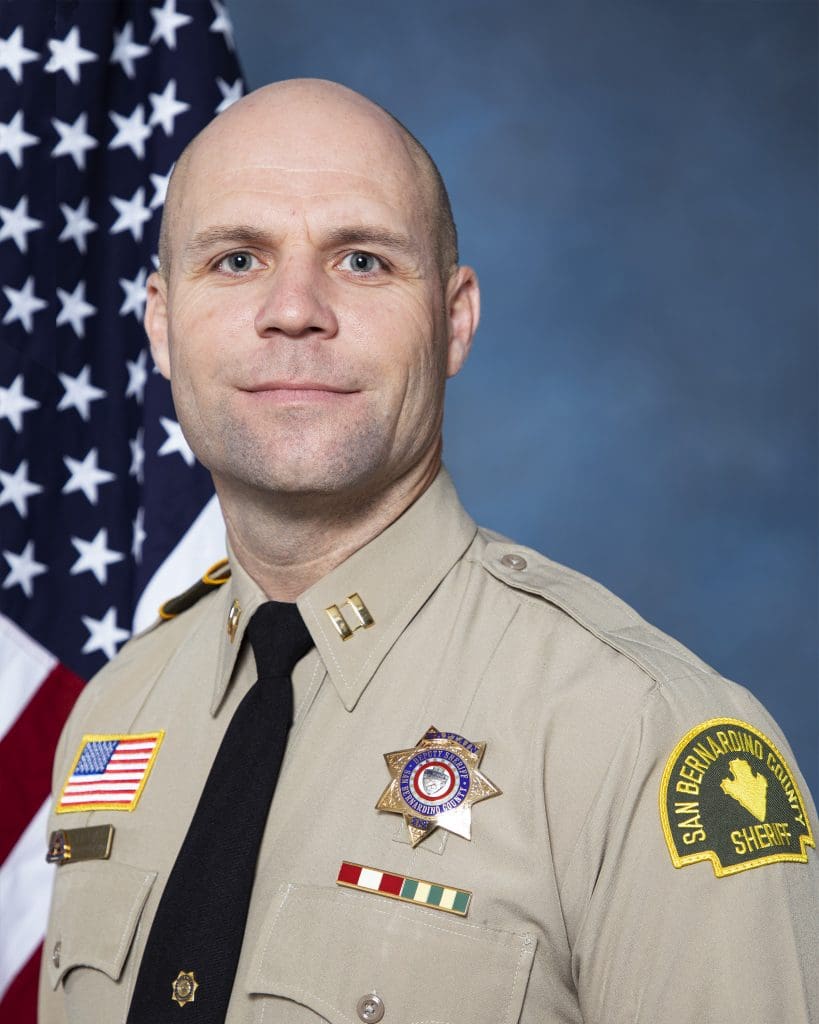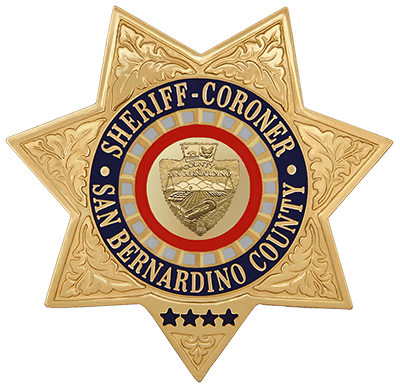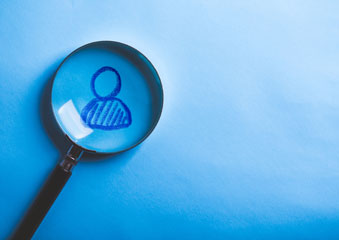Coroner

Joe Janowicz, Captain
Address:
175 South Lena Road
San Bernardino, CA 92415
Phone:
(909) 387-2978
Fax:
(909) 387-2989
Coroner Lobby Hours:
Monday through Friday, 8:30 am – 4:30 pm
MORTUARY RELEASE HOURS ARE WHEN THE LOBBY IS OPEN.
There will be no Mortuary Releases on Holidays.
HOLIDAY HOURS:
The Coroner Lobby will be closed on the following observed holidays in 2025:
MAY: Memorial Day: Monday, 05/26
JUNE: Juneteenth: Thursday, 06/19
JULY: Independence Day: Friday, 07/04
SEPTEMBER: Labor Day: Monday, 09/01
OCTOBER: Indigenous Peoples’ Day: Monday, 10/13
NOVEMBER: Veteran’s Day: Tuesday, 11/11;
Thanksgiving: Thurs & Fri, 11/27 & 11/28
DECEMBER: Christmas: Thurs & Fri, 12/25 & 12/26;
New Year’s Eve: Thursday, 12/31
Unidentified and missing persons Facebook Page
The Coroner Division
The responsibilities of the Coroner Division are many and complex. By state law, it is the duty of the Coroner Division to inquire and determine the circumstances, manner and cause of death (COD) for cases that fall within the Coroner’s jurisdiction. These deaths include suspected homicide, suicide, or accidental deaths. These also include natural deaths were there is no physician to sign the death certificate or the physician is legally prohibited from doing so. Additionally, other certain causes of death are also mandated to be investigated.
The manner and COD inquiries may require reviews of medical records, interviews with family members or witnesses, and postmortem examinations (autopsy). Forensic Pathologists (FP) are doctors specifically trained in forensic pathology. The FP’s perform autopsies, collect evidence, body fluids and tissues for toxicology testing and microscopic study. Upon completion of these tests, the doctors analyze all the results of the autopsy to determine the final COD. The COD is used to complete the decedent’s death certificate. Evidence collected during autopsies and at the scene may be used for criminal prosecution as well as determining COD. The doctors are frequently called to court to testify to the results of the autopsy. The coroner division is constantly on alert for deaths that may pose a threat to public health from communicable disease or through product liability.
The coroner division’s responsibilities also include the identification of decedents. Identification may be as simple as matching the decedent to a driver’s license or other identification documents. The identification process may utilize fingerprints, dental records, body x-rays or DNA testing. Locating the decedent’s next of kin, notifying them of the death and securing the decedent’s personal property are additional responsibilities of the department. In deaths where the decedent died at scene, deputy coroner investigators (DCI) are responsible for removal and transportation of the decedent. DCI’s will obtain information from family, friends, and public safety personnel regarding the terminal episode. The coroner division works with numerous medical and law enforcement agencies to understand how people lost their lives and to help bring answers to the loved ones of the deceased.
Pending Death Certificates
After performing an autopsy, the forensic pathologist can issue a “pending” cause of death and “pending investigation” manner of death. This is often because the doctor is waiting for the toxicology results (or blood/tissue results) to return from the lab. Blood and tissue specimens are collected during autopsies and sent to a laboratory for testing.
After the doctor receives the lab results, the doctor reviews the entire case and completes the autopsy report. The doctor will then amend or change the death certificate from pending to the final cause of death to reflect the official COD and manner of death. This process can take an average of six months, and sometime even longer, due to the complexity of the investigation, toxicology reports, histology reports and other testing that may be necessary to figure out the final cause of death.
Death Certificate
Copies of death certificates (DC) are often needed for insurance claims, pension benefits, to transfer titles and to complete other official financial business. A death certificate with a “pending” cause of death can often be used as proof of death. Some institutions will consider the pending COD document sufficient to complete certain transactions, such as closing accounts. However, some institutions (such as insurance companies) may not accept a DC with a pending COD and will require the official COD.
Answer: The decedent is transported to the coroner division in San Bernardino or, under certain conditions, directly to a mortuary/funeral home of your choice.
Answer: No. We do not allow visitation at the Coroner. We do not have a viewing facility or a place for families to see the body.
Answer: Contact a mortuary/funeral home of your choice to make arrangements for your loved one to be transported from the coroner division. The mortuary/funeral home will go over further arrangements that the family must choose.
Answer: Yes. You may call (909) 387-2978 between 8:00 a.m. and 4:30 p.m. After business hours, you may call the same number and will reach a dispatcher. You can ask to speak to a Coroner Investigator for urgent matters after hours.
Answer: Not always. If the death is a “natural death” and the decedent has a physician who has been treating or prescribing medication to the deceased for a known medical condition, and will provide the coroner division with an acceptable cause of death, the coroner division will normally not perform an autopsy.
Answer: No. Embalming is a service performed at a mortuary and chosen by the family to preserve the body for viewing. The coroner division does not embalm decedents transported to the Coroner’s division.
Answer: The California Department of Public Health created a web based system for death certificates called the Electronic Death Registration System (EDRS). This system has been online for more than ten years now. The system recently changed its name from EDRS to IVRS (Integrated Vital Records System). Death certificates are entered by the County where the person died; for example if the decedent died in Long Beach, the death certificate would be filed in Los Angeles County.
The death certificate record in EDRS is created by the mortuary/funeral home that is providing the services for the decedent. Once the mortuary completes demographic information, they must “flag” the record as needing input from the decedent’s doctor or the coroner. Once the cause of death is entered, the record is again, “flagged” for the mortuary to submit to the public health department, where it is reviewed for correctness before being given a local record number. If the information provided is incomplete or incorrect, the record is sent back to the mortuary to fix. After the local record number is given, the mortuary can apply for the burial or cremation permit. While this process usually happens quickly, there are occasions where obtaining the cause of death can have delays. Challenges can occur when the information provided in the record is declined by the coroner, public health department or there is an observed holiday and offices are closed.
There are three ways that a death certificate gets signed and attested:
- The primary treating doctor of the decedent provides the cause of death and then attests that cause or causes of death in EDRS.
- A Coroner’s forensic pathologist reviews the circumstances of the death and either performs an autopsy or reviews medical records and provides the cause of death. Coroner personnel then enters the cause of death into EDRS.
- The primary treating doctor reviews the circumstances of death and refuses to provide the cause of death. In those cases, the coroner division attempts to determine if the primary doctor should be compelled to provide the cause of death and attest the death certificate, or if the coroner’s forensic pathologist will attest the death certificate on behalf of the primary treating doctor.
Answer: There is no charge for an autopsy when the case falls within the Coroner’s jurisdiction such as a homicide, suicide, accident, or unknown circumstances. In cases where the Coroner division would not conduct an autopsy, the LEGAL next-of-kin may request a private autopsy to be performed. The charge for a private autopsy is $3,734.00. Payable by cashiers check or money order.
Answer: Yes. California’s Government Code Section 27472 authorizes the Coroner to charge a transportation fee of a deceased person. The San Bernardino Board of Supervisors approved this fee to be $348.00 for transportation from the scene or hospital to the Coroner’s facility. There may be additional transportation fees charged by the mortuary/funeral home. Mortuaries and funeral homes are private businesses and the Coroner has no authority over private businesses or what they may charge.
Answer: The Coroner will complete the death investigation as soon as possible and release the decedent to a mortuary/funeral home selected by the next-of-kin. Mortuary staff will assist the family in scheduling a time and date for the funeral or final arrangements.
Answer: The following is a list of the deaths the Coroner Division is required by law to investigate by CA state law:
- Unattended deaths. (No physician in attendance or during the continued absence of the attending physician.
- Wherein the deceased has not been attended by a physician in the 20 days prior to death.
- Physician unable to state the cause of death. (Unwillingness does not apply).
- Known or suspected homicide.
- Known or suspected suicide.
- Involving any criminal action or suspicion of criminal act.
- Related to or following known or suspected self-induced or criminal abortion.
- Associated with a known or alleged rape or crime against nature.
- Following an accident or injury (primary or contributory). Deaths unknown or suspected which resulted in whole or in part from a related accident or injury, either old or recent.
- Drowning, fire, hanging, gunshot, stabbing, cutting, starvation, exposure, acute alcoholism, drug addiction, strangulation or aspiration.
- Poisoning. (Food, chemical, drug, therapeutic agents).
- Occupational diseases or occupational hazards.
- Known or suspected contagious disease and constituting a public hazard.
- All deaths in operating rooms and all deaths where a patient has not fully recovered from an anesthetic, whether in surgery, recovery room or elsewhere.
- In prison or while under sentence.
- All deaths of unidentified persons.
- Suspected sudden infant death syndrome.
- All deaths of state hospital patients.




 Public Records
Public Records Parking Citations, Commendations, and Complaints
Parking Citations, Commendations, and Complaints Sign-up for Emergency Notification Alerts
Sign-up for Emergency Notification Alerts Crime Prevention
Crime Prevention Homicide Cold Cases
Homicide Cold Cases Community Events Calendar
Community Events Calendar